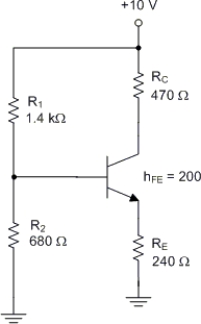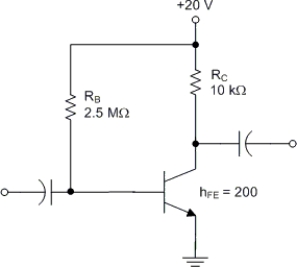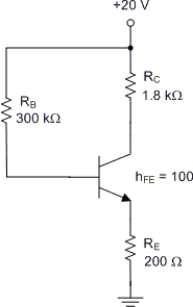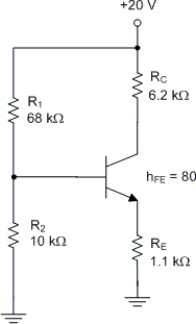Deck 7: DC Biasing Circuits
Question
Question
Question
Question
Question
Question
Question
Question
Question
Question
Question
Question
Question
Question
Question
Question
Question
Question
Question
Question
Question
Question
Question
Question
Question
Question
Question
Question
Question
Question

Unlock Deck
Sign up to unlock the cards in this deck!
Unlock Deck
Unlock Deck
1/30
Play
Full screen (f)
Deck 7: DC Biasing Circuits
1

Is the circuit in Figure midpoint biased?
A) Yes
B) No
No
2
The most commonly used type of transistor biasing is
A) voltage-divider bias.
B) emitter-feedback bias.
C) collector-feedback bias.
D) emitter bias.
A) voltage-divider bias.
B) emitter-feedback bias.
C) collector-feedback bias.
D) emitter bias.
voltage-divider bias.
3
The term quiescent means
A) midpoint biased.
B) at rest.
C) active.
D) Both A and B above.
A) midpoint biased.
B) at rest.
C) active.
D) Both A and B above.
at rest.
4
What is the primary drawback to using emitter bias?
A) Emitter bias is beta dependent.
B) Emitter bias cannot provide midpoint bias.
C) Emitter bias requires the use of a dual-polarity power supply.
D) Emitter bias has no quiescent state.
A) Emitter bias is beta dependent.
B) Emitter bias cannot provide midpoint bias.
C) Emitter bias requires the use of a dual-polarity power supply.
D) Emitter bias has no quiescent state.

Unlock Deck
Unlock for access to all 30 flashcards in this deck.
Unlock Deck
k this deck
5
As temperature increases, the value of hFE
A) increases.
B) decreases.
A) increases.
B) decreases.

Unlock Deck
Unlock for access to all 30 flashcards in this deck.
Unlock Deck
k this deck
6

The value of VCEoff) for the circuit in Figure is
A) 20 V.
B) 10 V.
C) 5 V.
D) Cannot be determined with the information given.

Unlock Deck
Unlock for access to all 30 flashcards in this deck.
Unlock Deck
k this deck
7

The value of ICsat) for the circuit in Figure is
A) 21.3 mA.
B) 14.1 mA.
C) 7.04 mA.
D) 0 mA.

Unlock Deck
Unlock for access to all 30 flashcards in this deck.
Unlock Deck
k this deck
8
An emitter bias circuit has values of VCC = +8 V and VEE = -8 V. The value of VCEoff) for the circuit is
A) 4 V.
B) 8 V.
C) 16 V.
D) 0.7 V.
A) 4 V.
B) 8 V.
C) 16 V.
D) 0.7 V.

Unlock Deck
Unlock for access to all 30 flashcards in this deck.
Unlock Deck
k this deck
9
Why is midpoint bias desirable for most linear amplifiers?
A) It extends the operating life of the transistor.
B) It allows optimum ac operation of the circuit.
C) It allows optimum dc operation of the circuit.
D) It keeps VCEQ at approximately half the value of VCC.
A) It extends the operating life of the transistor.
B) It allows optimum ac operation of the circuit.
C) It allows optimum dc operation of the circuit.
D) It keeps VCEQ at approximately half the value of VCC.

Unlock Deck
Unlock for access to all 30 flashcards in this deck.
Unlock Deck
k this deck
10
The value of ICsat) for the circuit in Figure is
A) 1 mA.
B) 0 mA.
C) 2 mA.
D) 4 mA.
A) 1 mA.
B) 0 mA.
C) 2 mA.
D) 4 mA.

Unlock Deck
Unlock for access to all 30 flashcards in this deck.
Unlock Deck
k this deck
11

The value of VCEoff) for the circuit in Figure is
A) 10 V.
B) 20 V.
C) 5 V.
D) 0 V.

Unlock Deck
Unlock for access to all 30 flashcards in this deck.
Unlock Deck
k this deck
12
The change in ICQ and VCEQ that can occur when temperature changes is known as
A) midpoint bias.
B) midpoint shift.
C) output shift.
D) Q-point shift.
A) midpoint bias.
B) midpoint shift.
C) output shift.
D) Q-point shift.

Unlock Deck
Unlock for access to all 30 flashcards in this deck.
Unlock Deck
k this deck
13
Which of the following is the likely to experience significant changes in the values of ICQ and VCEQ as a result of changes in temperature?
A) Voltage-divider bias.
B) Emitter-feedback bias.
C) Base bias.
D) Collector-feedback bias.
A) Voltage-divider bias.
B) Emitter-feedback bias.
C) Base bias.
D) Collector-feedback bias.

Unlock Deck
Unlock for access to all 30 flashcards in this deck.
Unlock Deck
k this deck
14
Which of the following is a characteristic of emitter bias ?
A) The emitter potential is very low, typically less than -1 V.
B) The base potential is very close to 0 V.
C) The collector potential is approximately equal to VCC.
D) All of the above are characteristic of emitter bias.
E) Both A and B are characteristic of emitter bias.
A) The emitter potential is very low, typically less than -1 V.
B) The base potential is very close to 0 V.
C) The collector potential is approximately equal to VCC.
D) All of the above are characteristic of emitter bias.
E) Both A and B are characteristic of emitter bias.

Unlock Deck
Unlock for access to all 30 flashcards in this deck.
Unlock Deck
k this deck
15
The spec sheet for a given transistor contains the following table: hFE = 5 to 200 when IC = 1 mA hFE = 70 to 350 when IC = 10 mA hFE = 100 to 400 when IC = 20 mA hFE = 150 to 450 when IC = 100 mA
The transistor is being used in a circuit with the following values: VCC = 20 V, RC = 820 Ω, and RE = 180 Ω. What value of hFE should be used in the analysis of the circuit?
A) 100
B) 157
C) 200
D) None of these are correct.
The transistor is being used in a circuit with the following values: VCC = 20 V, RC = 820 Ω, and RE = 180 Ω. What value of hFE should be used in the analysis of the circuit?
A) 100
B) 157
C) 200
D) None of these are correct.

Unlock Deck
Unlock for access to all 30 flashcards in this deck.
Unlock Deck
k this deck
16
Base bias is used primarily in switching applications.

Unlock Deck
Unlock for access to all 30 flashcards in this deck.
Unlock Deck
k this deck
17
The simplest transistor biasing circuit is called
A) voltage-divider bias.
B) emitter-feedback bias.
C) base bias.
D) collector-feedback bias.
A) voltage-divider bias.
B) emitter-feedback bias.
C) base bias.
D) collector-feedback bias.

Unlock Deck
Unlock for access to all 30 flashcards in this deck.
Unlock Deck
k this deck
18

Is the circuit in Figure midpoint biased?
A) Yes
B) No

Unlock Deck
Unlock for access to all 30 flashcards in this deck.
Unlock Deck
k this deck
19
A transistor has a rating of hFE = 50 to 450. What value of hFE should be used for circuit analysis purposes?
A) 50
B) 250
C) 450
D) 150
A) 50
B) 250
C) 450
D) 150

Unlock Deck
Unlock for access to all 30 flashcards in this deck.
Unlock Deck
k this deck
20

Is the amplifier in Figure midpoint biased?
A) Yes
B) No

Unlock Deck
Unlock for access to all 30 flashcards in this deck.
Unlock Deck
k this deck
21

Is the circuit in Figure midpoint biased?
A) Yes
B) No

Unlock Deck
Unlock for access to all 30 flashcards in this deck.
Unlock Deck
k this deck
22

The circuit has measured values of VB = 2.2 V, VE = 1.5 V and VC = 11.5 V. Which of the following could account for these readings?
A) The 68 kΩ resistor is open.
B) The 10 kΩ resistor is open.
C) The 6.2 kΩ resistor is open.
D) The 1.1 kΩ resistor is open.
E) There is no fault. The circuit is functioning as it should.

Unlock Deck
Unlock for access to all 30 flashcards in this deck.
Unlock Deck
k this deck
23
What type of bias requires the use of a dual-polarity power supply?
A) Base bias
B) Emitter bias
C) Voltage-divider bias
D) Collector-feedback bias
Chapter 7 DC Biasing Circuits Answer Key
A) Base bias
B) Emitter bias
C) Voltage-divider bias
D) Collector-feedback bias
Chapter 7 DC Biasing Circuits Answer Key

Unlock Deck
Unlock for access to all 30 flashcards in this deck.
Unlock Deck
k this deck
24

The circuit in Figure found to be in saturation. Which of the following could cause this condition?
A) A open base resistor RB
B) An open collector resistor RC
C) An open transistor Q1 base-to-emitter
D) A shorted base resistor RB

Unlock Deck
Unlock for access to all 30 flashcards in this deck.
Unlock Deck
k this deck
25

Refer to Figure The circuit is an) .
A) base bias
B) emitter bias
C) voltage-divider bias
D) collector feedback
E) emitter-feedback

Unlock Deck
Unlock for access to all 30 flashcards in this deck.
Unlock Deck
k this deck
26

What type of bias is shown in Figure ?
A) Base bias
B) Emitter bias
C) Voltage-divider bias
D) Emitter-feedback bias
E) Collector-feedback bias

Unlock Deck
Unlock for access to all 30 flashcards in this deck.
Unlock Deck
k this deck
27

Refer to Figure 7-5. The circuit has measured values of VB = 1 V, VE = 0.3 V and VC = 0.4 V. Which of the following could account for these readings?
A) The 68 kΩ resistor is open.
B) The 10 kΩ resistor is open.
C) The 6.2 kΩ resistor is open.
D) The 1.1 kΩ resistor is open.
E) There is no fault. The circuit is functioning as it should.

Unlock Deck
Unlock for access to all 30 flashcards in this deck.
Unlock Deck
k this deck
28

Refer to Figure 7-5. The circuit has measured values of VB = 0 V, VE = 0 V, and VC = 20 V. Which of the following could account for these readings?
A) The 68 kΩ resistor is open.
B) The 10 kΩ resistor is open.
C) The 6.2 kΩ resistor is open.
D) The 1.1 kΩ resistor is open.
E) There is no fault. The circuit is functioning as it should.

Unlock Deck
Unlock for access to all 30 flashcards in this deck.
Unlock Deck
k this deck
29

The value of Rbase for the circuit is
A) 1.1 k Ω.
B) 88 k Ω.
C) 8.97 k Ω.

Unlock Deck
Unlock for access to all 30 flashcards in this deck.
Unlock Deck
k this deck
30
What type of bias is used primarily in switching circuits?
A) Base bias
B) Emitter bias
C) Voltage-divider bias
D) Collector-feedback bias
A) Base bias
B) Emitter bias
C) Voltage-divider bias
D) Collector-feedback bias

Unlock Deck
Unlock for access to all 30 flashcards in this deck.
Unlock Deck
k this deck



